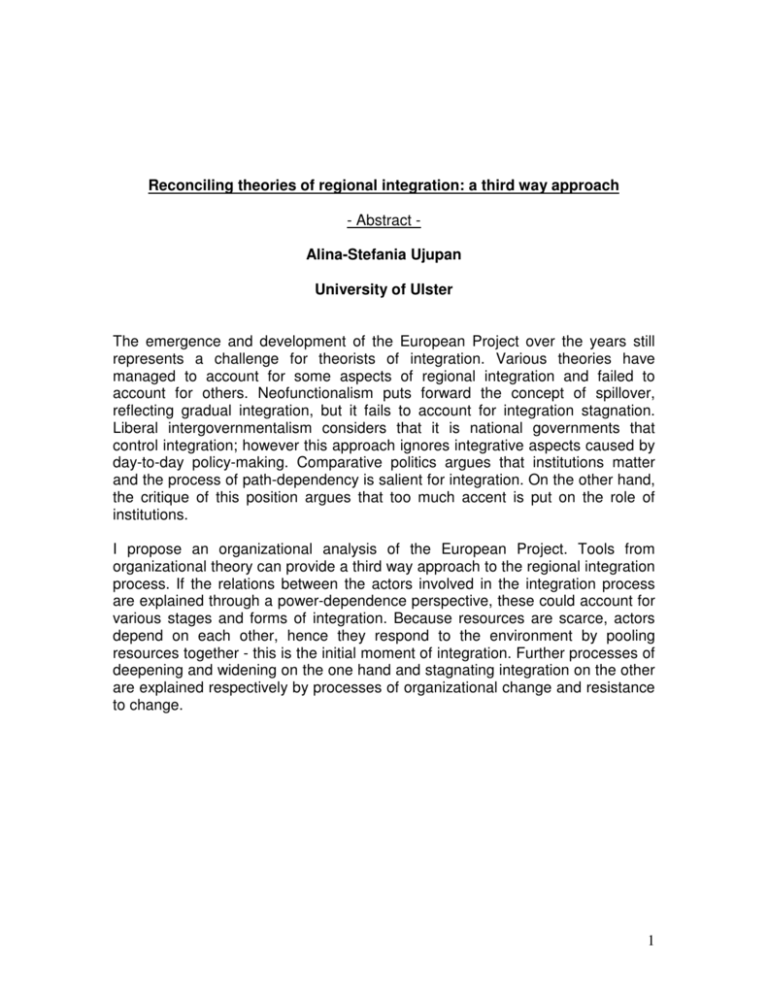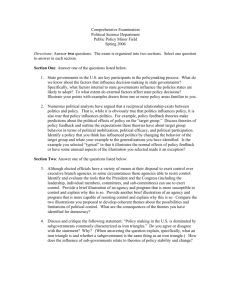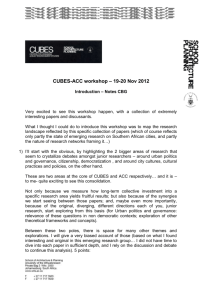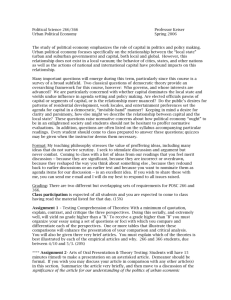1 Reconciling theories of regional integration: a third way approach
advertisement

Reconciling theories of regional integration: a third way approach - Abstract Alina-Stefania Ujupan University of Ulster The emergence and development of the European Project over the years still represents a challenge for theorists of integration. Various theories have managed to account for some aspects of regional integration and failed to account for others. Neofunctionalism puts forward the concept of spillover, reflecting gradual integration, but it fails to account for integration stagnation. Liberal intergovernmentalism considers that it is national governments that control integration; however this approach ignores integrative aspects caused by day-to-day policy-making. Comparative politics argues that institutions matter and the process of path-dependency is salient for integration. On the other hand, the critique of this position argues that too much accent is put on the role of institutions. I propose an organizational analysis of the European Project. Tools from organizational theory can provide a third way approach to the regional integration process. If the relations between the actors involved in the integration process are explained through a power-dependence perspective, these could account for various stages and forms of integration. Because resources are scarce, actors depend on each other, hence they respond to the environment by pooling resources together - this is the initial moment of integration. Further processes of deepening and widening on the one hand and stagnating integration on the other are explained respectively by processes of organizational change and resistance to change. 1 Introduction: This paper aims to contribute to the debate on theories of regional integration. It proposes the use of elements of organizational theory to tackle theoretical shortcomings of integration approaches. The European project is taken as a framework for discussion; however the aim is to generalize the conclusions of this analysis to any case of regional integration. The ground theories of regional integration come from the field of International Relation (IR). These looked at integration as process. Later in the 1980s theories from Comparative Politics (CP) also aimed to explain integration, but in their attempt they approached integration from the governance point of view (Rosamond, 2001). In the first part of this paper, IR and CP theories will be discussed in terms of achievements and shortcomings, while the second part will introduce organizational theory elements to tackle these shortcomings. The aim of this paper is not to build up a groundbreaking theory; it rather aims to enhance understanding of the integration process and to bring about a somehow different perspective which hopefully will contribute at reconciling competing integration approaches. Part I The starting point for integration theories discussion is Ben Rosamond’s book ‘Theories of European Integration’. The two main IR theories that affected regional (European) integration debate are neofunctionalism and intergovernmentalism. Neofunctionalist theory was centred on some core ideas. In the view of neofunctionalists the society was composed of various groups of interests and the integration process would better satisfy them. Essential for the neofunctionalist thesis is the idea of spillover according to which integration would deepen from economic to political and the result would be an integrated union of states (and their societies) which would acquire the characteristics of ‘domestic political systems’ (Rosamond, 2001). Another key element was the existence of a high authority (above the nation states) which would give the integration process the right direction. A high authority which wrongly guides member states, would be in the view of neofuntionalists the definite element that drives that given union to failure. 2 The integration process would be led by technocratic elites and therefore governance of the union would not be based on ideological grounds, but on pragmatic satisfaction of interests and on technocratic expertise. Edmund Haas, the founding father of neofunctionalism based his initial thesis on the idea of loyalty. In this sense, political spillover would be accomplished through a process of loyalty transference from the nation state to the high authority (authorities) (Haas in Rosamond, 2001) Although initially the process of spillover was regarded as one directional, Lindberg and Scheingold also accepted the idea of spillback. They argued the fact that integration could stop or slow down further integration due to the pressure that it causes among member states. The critique of neofunctionalism is rich and varied. One of the ideas mostly criticized is that of the decreased role and authority of the member state. Empirical evidence indicated the opposite and even ethical arguments were evoked such as those that the state was the guardian of key values of liberty and justice in the society (Rosamond 2001). The idea of spillover, particularly the fact that economic integration would lead to political integration was challenged by various critics, most laying down the basis of intergovernmentalism through their critique. Hoffmann, particularly did not agree that integration of economy could lead to political integration as he saw economics and politics as relatively independent from each other. He made the distinction between high and low politics. Low politics would be the more technocratic issues which did not involve too much sovereignity transfer from the member state and therefore in such case integration would be possible. High politics would be a different issue – this concept refers to key policies of member states such as defence, taxation, macroeconomic strategies. Hoffmann argues that in these areas the nation state would not accept sovereignity transfers in favour of a high authority. Of course, more recent events in the European Union (EU) such as the creation of Economic and Monetary Union (EMU) and Common Foreign and Security Policy (CFSP) could challenge his argument (Rosamond, 2001). Fairly on the same line of argument is Hansen. In his view neofunctionalists made three critical errors: not making a high/low politics distinction, not placing the European project in an international context, and refusing to accept that mutual economic gains can exist and can be obtained without a supranational high authority. Neofunctionalists, particularly Haas, later responded to some of these critiques. He argued that integration should cease to be a study in its own right and 3 attention should be focused on interdependence and through this on the multiactor complexity. Intergovernmentalism appeared as a reaction to neofunctionalism and was rooted in two currents: neorealism whose core ideas were that the distribution of capabilities between member states induces differences of power, and neoliberalism, which focused on the interaction of states’ interests. An intergovernmental view was put forward by Putnam, who viewed integration (governance) as a two level game played by the member states – at the national level office holders build coalitions among domestic groups; at the European level they bargain in ways that enhance their position at the domestic level by satisfying demands of key interest groups. The mostly referred vision of intergovernmentalism nowadays is Moravcsik’s liberal intergovernmentalism thesis. It is influenced by the works of Keohane on neoliberal institutionalism (Rosamond, 2001). Moravcisk argues that integration goes as far as member states want it to go and European institutions exist due to the deliberate will of member states to satisfy their interests and are instruments for achieving member states’ objectives. The European level is the location where member states strategically bargain their interests, defined within domestic level negotiations. Intergovernmentalism and particularly Moravcsik’s thesis was argued to somehow strengthen neofunctionalist beliefs. Lindberg, for example, states that member states’ behaviour in negotiations at the European level gaining autonomy and space of manoeuvre in relation to their domestic constituencies, could also account for the European Commission. Others criticise (liberal) intergovernmentalism for being an approach rather than a theory (Wincott in Rosamond, 2001), because Moravcsik fails to define the circumstances in which this ‘theory’ could be empirically refuted – a criticism similar to that experienced by neofunctionalist. He also argues that Moravcsik’s approach fails to account for the day-to-day policy-making where bargaining is not the norm and he also does not account for interactions among institutions and the impact of membership (Pollak, 2001). Comparative Politics approach, as earlier argued, addressed the governance aspect of integration rather than the process. Multi-level governance (MLG) emphasises the great number and complexity of actors that affect European governance. Integration has favoured devolution of power from the state to both sub- and supra-national levels, but with significant differences among sectors of policy-making. For MLG advocates ‘the normal politics of sovereignity is, therefore, a politics of absolutes’ (Rosamond, 2001:110). The ‘multi-level’ feature of the EU was perceived in different ways. Peterson and Bomberg (1999) suggest differentiating among levels of policy-making: sub-systemic, systemic 4 and historical or supra-systemic. Each level can be explained by certain theories of integration. Similarly, Richmond separates the policy process in different stages. Both views emphasise the fact that ‘alternative theories [of integration] can coexist in EU studies’ (Rosamond, 2001:112). Multi-level governance was criticised for being too static and not able to account for the dynamics of integration. Advocates of historical institutionalism (Pierson, 1996) state that integration takes place due to that lack of ability of nation governments to control and foresee the effects of their decisions. Between two intergovernmental ‘highly political’ agreements, small changes may occur and actors from sub- or supra-national levels, including institutions, enhance their power and slowly swing the balance more favourably for them and create ‘path dependencies’. Other branches of institutionalism are rational choice and cultural institutionalism. For rational choice institutionalists institutions are ‘the formal rules of the game’ (Pollack, 2001). They become more and more autonomous through the institutionalization of EU legal norms (Amstrong and Bulmer in Rosamond, 2001). Sociological approaches of institutionalism include besides formal rules of the game, informal norms. They address the cultural and identity aspects of institutions. It is similar to constructivist approaches in this sense. The development of a European culture and of a special identity of civil servants members of EU institutions impacts on their perceptions and interests. On the other hand, constructivist scholars criticized institutionalists for failing to explain phenomena such as identity and preference change (Pollack, 2001). One can observe the richness of perspectives through which the process of integration, and the European case in particular, have been analyzed. It is difficult to create an overarching approach because integration is complex. The aim of the next section of the paper is to enhance our understanding of integration processes through organizational lenses. Part II Organizational theory encompasses a vast field of research and it would be impossible to provide here an overview of all the aspects addressed in relation to organizations. However, its richness of concepts enables a better understanding of the EU integration process and its functioning. If we ask ourselves the question of why do organizations emerge, the logical answer that comes to one’s mind is that organizations are better means of satisfying the individuals’ interests than each of them would satisfy on their own. Individuals’ interests are not necessarily pragmatic, they could also be ideological. Going back to the post war era, the interest that founding fathers and European states had was to avoid such a catastrophe to happen again. Conflicts 5 do not arise between highly interdependent states because none of them affords such actions. From the organizational point of view this explains the emergence of the European project by putting together the coal and steel resources under the jurisdiction of a high authority. Fairly all theoretical perspectives agree with the explanation of the emergence of the European project. Disagreements appear concerning the way this project evolved and is governed. Organizations exist because of their ability to create value and acceptable outcomes for various groups of stakeholders, where stakeholders are actors who have an interest, claim or stake in the organization, in what it does, and in how well it performs (Jones, 2004). Stakeholders are motivated to join and participate in an organization as long as the 'inducements' they receive exceed the value of the contribution they make for the organization to exist (op. cit. 2004: 31). Thus, an organization is used by different groups of stakeholders at the same time, and the purpose of each of them is to accomplish its own goals. The effectiveness of the organization varies for each group, as each group evaluates the organization by judging how well it fulfils the specific group's goals. Obviously, the goals of stakeholders vary and can be contradictory, therefore they bargain over their gains. One paradox of the organization, which is also characteristic for the EU, is that stakeholder groups are engaged in a process of continuous and simultaneous competition and collaboration, which is actually the essence of the organization (Jones, 2004; Morgan, 1998). All stakeholders are interested in the survival of the organization, as an elementary condition for pursuing their goals, and in this sense they collaborate. They compete over the allocation of gains in order to maximize their interests. As Bacharach and Lawler (1998) argue, actors generally operate between cooperation and competition, they compete when necessary and they collaborate when necessary; no actor aims to annihilate the others, but in the same time, no actor will give up its own goals to cooperate on every issue purely for the purpose of organizational harmony or for the gains of the total organization. From my point of view each member state is a stakeholder in the EU, joining the ‘club’ for its own interests and fighting inside it for satisfying its interests. In time, member states join the ‘club’ for the same reasons as the ‘creators’ of the club: because they believe that inside it their interests are better satisfied than being outside. We must not think of member states of monoliths, but rather as organizations on their own, inside which preferences are negotiated until a common position is agreed. It also must be argued that stakeholders are not equal, some have more ‘shares’ than others, hence more weight. It is the same with member states in the EU. As Bacharach and Lawler (1980) argue, stakeholders are characterized by bases of power and the most powerful pursue most of their own objectives. 6 Let us consider now the way in which EU functions. Like in any organization, EU membership is governed by norms and procedures encompassed in the acquis communautaire, but also by interpersonal alliances, networks and informal interactions and controls (Hooghe 1998, Lewis 1998, 2001). One of the core issues of disagreement among theories of integration was the statute, importance and power of supranational institutions. Here the situation is similar to that inside of an organization. In any organization stakeholders transfer power and control to a system of management which decides and implements policies for the organization. Like in Principal-Agent theory, the system of management will influence organizational preferences and priorities, but at the same time it will take account of stakeholders’ preferences in order to avoid loss of position. The European Summits, on the other hand are similar to stakeholders’ meetings in the organization, to take decisions of major importance. Another point of debate among theories of integration, particularly neoinstitutionalism and intergovernmentalism, referred to the integration process itself. Neofunctionalists argued for gradual integration and spillover. This concept could not explain stagnation and the 1966 Luxembourg crisis. For intergovernmentalists integration is a process well controlled by the member states, where they delegate just as much authority as needed for institutions to meet their interests. Organizational theory is helpful again. An organization lives within an environment and it is in a continuous process of adaptation both externally and internally. Causes of changes can vary. They can be economic such as globalization; social – various changes in society modifying individual and social needs; or technological – the development of new technologies. In the case of the EU, it has to adapt to globalization and to the changing needs of its societies. Moreover, new technologies need new laws, strengthening this way the role of the EU. We may also add a fourth source of change: politics. Political changes both at the domestic and international level determines EU to react. A recent case is the collapse of the Eastern block which pushed towards an EU enlargement. Integration stagnation is a phenomenon of resistance to change. It is claimed that the most important factor of change is people and they react in three ways to change: by resisting to it, by following it, or by taking a leadership position and orchestring changes (Jones, 2004). The Luxembourg crisis is obviously a process of resistance to change, as are the rejections of the Maastricht Treaty by the Danes; of the Nice Treaty by the Irish or of the European Constitution by the French and the Dutch. We also have in the EU states that take leadership positions – such as the Big Three and states that follow these in their actions. 7 Jones (2004) argues that the goal of an organization is to minimize its dependence on other organizations for the supply of scarce resources in its environment and to find ways to influence them in order to make resources available. This is another justification for which EU enlarges. The question that rises here is then until when and where it enlarges and how deep will it integrate. In my view organizational theory also has an answer for the ‘finalite’ issue of the European Union. In the case of organizations, viewed as built up by various stakeholders, various interest groups which bargain and struggle for power and influence, goals change. In the organization, stakeholders bargain with each other for the distribution of organizational gains. Not all stakeholders are equally satisfied; it is the most powerful alliance of stakeholders that dictates the way in which the distribution of gains is carried out (Jones, 2004). Stakeholders are not equally powerful and their interactions, whether collaborative or competitive, are shaped by power-dependence variables (Bacharach and Lawler, 1980). Goals change as the balance of power changes inside the organization. In the EU too, balances change. We have old members and new members, we have states gaining influence such as UK, Spain or Poland and we have states losing influence, like France. Even inside member states we have changes of governments, hence changes of priority. Since the definition of EU trajectory strongly depends on these internal shifts we cannot anticipate where EU will go, as we cannot anticipate where any other organization goes. It can only be stated that the EU structures will continuously adapt to the needs of its component interest groups and it will react to its external environment. It does not need a finalite. A final dimension to be addressed here is the issue of identity, culture and preference change. There is a large body in organizational theory that addresses the development of organizational culture. Particularly large organizations develop an organizational culture; they cultivate the feeling of belonging to that organization. Identities, preferences and values are shaped by the internal informal environment of the organization. Hence, organizational theory can also account for ‘sociological’ dimension of the EU. Conclusion: This paper aimed at providing a ‘third way’ explanation of regional integration by using organizational theory and the EU as a framework of analysis. Several aspects have been addressed here. The EU is regarded as an organization where member states are its stakeholders. The initial moment of integration is explained by resource interdependence and interests of the founding states. Spillover and stagnation are explained as processes of organizational change 8 and resistance to change. The existence of supranational institutions is justified by the necessity of delegating decision-making power to a management system. The issue of finalite is also explained through the purpose of the organization: to better meet the needs of its members than they would do on its own. Hence the organization will adapt to the changing needs. Finally, the branch of organizational culture from organizational theory studies is able to account for the formation of identities and values inside the organization. References: Amstrong K. and Bulmer, S. (1998) The Governance of the Single European Market, Manchester: Manchester University Press. BACHARACH, S. B. and LAWLER, E. J. 1980. Power and politics in organizations. San Francisco: Jossey-Bass Publishers. BACHARACH, S. B. and LAWLER, E. J. 1998. Political Alignments in Organizations: Contextualization, Mobilization and Coordination, in Kramer, R. M. and Neale, M. A. (eds.) Power and Influence in Organizations. Thousand Oaks: Sage Publications. Haas, E. B. (1958) The Uniting of Europe: Political, Social and Economic Forces 1950 – 1957. Stanford: Stanford University Press. Haas, E. B. (1975) Is there a Hole in the Whole? Knowledge, Technology, Interdependence and the Construction of International Regimes, International Organization 29 (3). Hansen, R. D. (1969) European Integration: Reflections on a Decade of Theoretical Efforts World Politics 21(2) JONES, G. R. 2004. Organizational Theory, Design, and Change (4th ed.). New Jersey: Prentice Hall. Lindberg, L. N. and Steigold, S. A. (1970) Europe’s Would-Be Polity: patterns of Change in the European Community. Englewood Cliffs, NJ: Prentice Hall. Marks, G., Hooghe, L., and Blank, K. (1996) European Intergration form the 1980s: State-Centric v. Multi-level Governance, Journal of Common Market Studies, 34 (3). Moravcsik, A. (1993) Preferences and Power in the European Community: A Liberal Intergovernmentalist Approach, Journal of Common Market Studies, 31(4). 9 MORGAN, G. 1998. Images of organizations. Thousand Oaks: Sage Publications. Peterson, J and Bomberg, E. (1999) Decision-Making in the European Union, Basingstoke: Macmillan. Rosamond, Ben (2000) Theories of European Integration, London: Macmillan Press Ltd. Pollack, M. A. (2001) International Relations Theory and European Integration, Journal of Common Market Studies, 39 (2), pp. 221-44. 10





